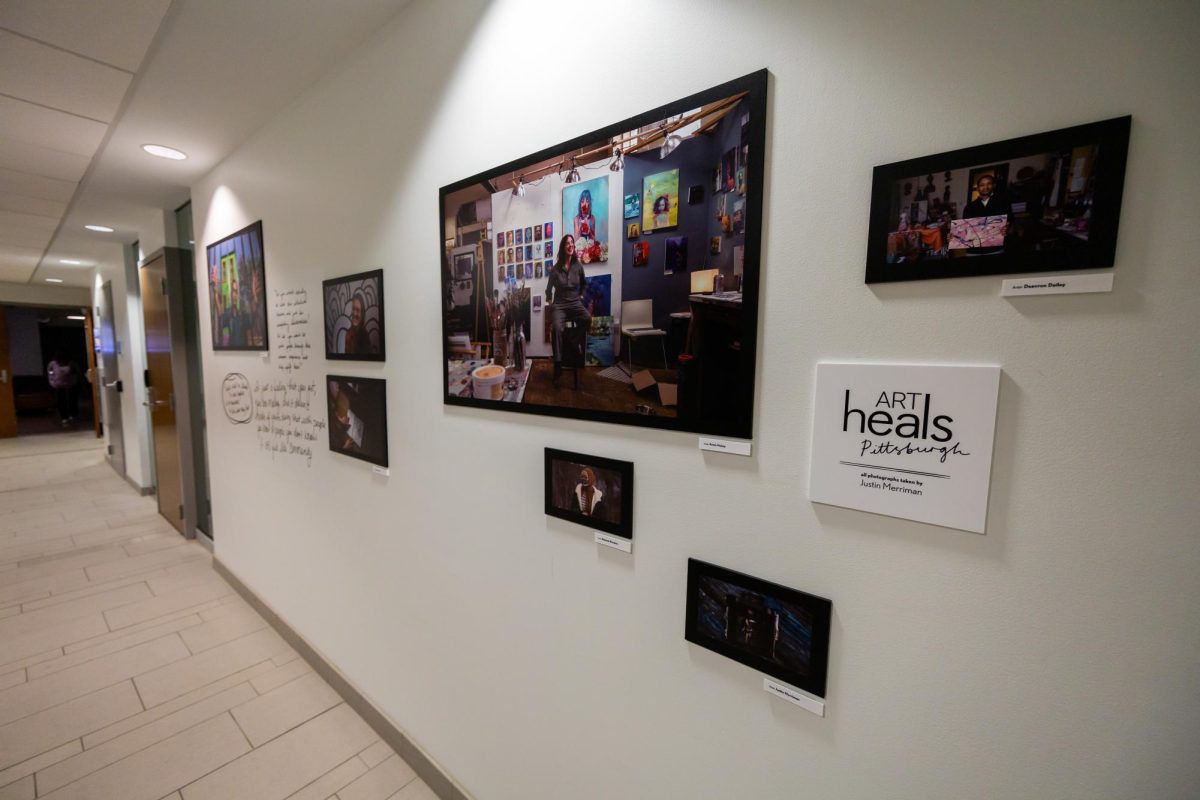Divided Sky looks at nature through technology
September 7, 2010
“Divided Sky”
Michael Sherwin
Pittsburgh… “Divided Sky”
Michael Sherwin
Pittsburgh Filmmakers Gallery
447 Melwood Ave.
Runs until Oct. 17
Monday through Thursday: 12-7 p.m., Friday: 12-6 p.m.
Michael Sherwin finds comfort in nature.
Growing up in southwestern Ohio, he spent most of his time outdoors, and today, when he isn’t spending time hiking, camping or taking his young daughter for walks, he channels his passion for nature into art.
But if you’re looking for photographs of pretty sunsets or rolling hills, you won’t find them anywhere in his collection, titled “Divided Sky,” at the Pittsburgh Filmmakers Gallery on Melwood Avenue. Instead, you’ll find elements of nature mixed with something many of us are much more familiar with: media and social networking.
The series of prints titled “In the Clouds” is a perfect example.
Sherwin took daily photographs of the sky behind his house and placed them side by side. The photos each reflect a certain mood – some days the skies are bright blue and scattered with clouds, while others are overcast and dreary. Over the top of the clouds float yellow-printed Facebook status updates of his friends, with lines like, “I hope today doesn’t suck,” and, “I should probably get out of bed.”
“They’re both sort of ‘updates’ but in an opposite way. I guess it’s a subtle commentary on contemporary social phenomenon. We connect through wires, but are disconnected with the outside world,” he said.
“In the Clouds” is one of the few pieces with Sherwin’s original photography; the rest are made up of images craftily pulled from technology.
To make the “True North Archive” series, he took tile-sized images from a foggy webcam at the North Pole and placed them together like a mosaic.
Similarly, for his piece titled “World Wide Web,” Sherwin “virtually-circumnavigated” the globe using Earthcam.com, a website that hosts links to thousands of webcams across world. While it took Magellan three years to circumnavigate by sea, it took Sherwin only one week to click on every webcam the site had to offer.
“A lot of webcams I found were broken or just deadpan pictures of courtyards or backyards. Some of them are still transmitting images but you have no idea what you’re looking at,” he said.
He spent a day and a half creating a grid on the wall with strips of adhesive vinyl to represent lines of longitude and latitude and then placed selected images in respect to their webcam’s geographical location.
Up close, it’s hard to tell what exactly the fuzzy images of “World Wide Web” represent, but after a few steps back, the photos take on a broader meaning.
“After putting the images on the grid, shapes of continents began to form … Europe had an abundance of webcams, but they started to trickle off in Africa. It turned into a social statement that I never expected,” he said.
In the gallery, next to “World Wide Web,” lies the most epic piece of the exhibit: “It’s All Relative,” a 50-channel video installation of a solar and lunar eclipse.
Unlike a typical filmmaker, Sherwin gathered all of his material from YouTube. The videos slowly appear on the wall, each one chiming into the cacophony until it’s hard to tell which shots are by amateur stargazers and which are by scientists.
But it’s not really the phases of the moon that mystify him — it’s the need human beings have to connect with one another.
“The phenomenon essentially becomes our fascination with this event, becoming bigger than the actual eclipse itself,” he said. “It also represents the ‘constant chatter’ we experience every day.”
As a professor at West Virginia University, Sherwin often finds that students, and even himself, get caught up in the “constant chatter” of texting and computing. To escape the clamor of everyday life, he offers a photography workshop for aspiring student artists in Jackson Hole, Wyo.
“We don’t just take pretty pictures. We look for the connection between nature and culture. The goal is not to be negative — rather, it’s to observe and ask ourselves what we think of the world around us,” he said.
The workshop takes place next June, and he encourages any interested college students to apply.
Concerning his work at the Filmmakers Gallery, Sherwin admits his use of appropriated images might seem mysterious and ambiguous at times.
“I like that the viewer has to work a little bit to try and make sense of the piece. Even if they don’t always understand it, I’m enjoying the fact that some of the work is kind of open-ended,” he said.
For those interested art lovers, Sherwin will bdiscuss his artwork and process at the Filmmakers Gallery on Sept. 30 at 6 p.m., with a reception following immediately after.
For more information on Sherwin’s photography workshop go to http://art.ccarts.wvu.edu/environment/jhpw.







